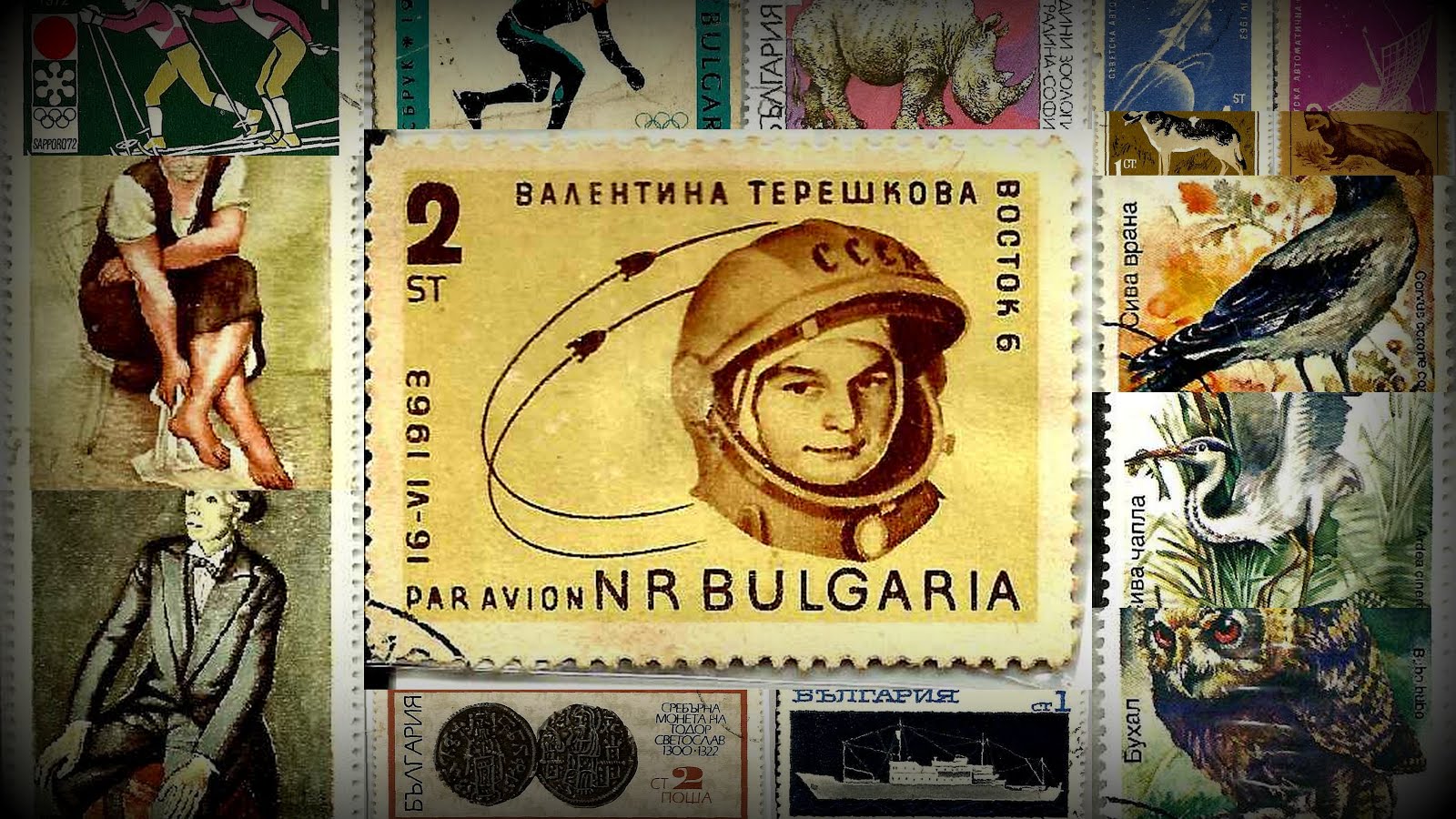 |
| Bulgaria Air Mail Team Manned (Valentina Tereshkova) Space Flights |
1963, Bulgaria Air Mail Team Manned (Valentina Tereshkova) Space Flights 2 Bulgarian Stotinki
Text: Valentina Tereshkova 2 Bulgarian stotinka 16-VI-1963 PAR AVION
Condition: Ø = used/cancelled
Title: Moon
Probes
Face value: 2
Stamp Currency: Bulgarian stotinka
Country/area: Bulgaria
Year: 1963
Set: 1963
Luchtpost
Stamp number in set: 1
Basic colour: Brown, Yellow
Exact colour:
Usage:
Airmail
Type: Stamp
Theme: Astronautics
Stamp subject:
Michel number: 1395
Yvert number:
Scott number:
Stanley Gibbons number: 1387
Printing office:
Perforation: L 11
Printing: Photogravure
Buy Now: Bis Now:
Valentina Tereshkova
Valentina Vladimirovna Tereshkova (Russian: Валенти́на Влади́мировна
Терешко́ва; born 6 March 1937) is a retired Soviet cosmonautand the first woman
to have flown in space, having been selected from more than four hundred
applicants and five finalists to pilot Vostok 6 on 16 June 1963. In order to
join the Cosmonaut Corps, Tereshkova was only honorarily inducted into the
Soviet Air Force and thus she also became the first civilian to fly in
space.[1] During her three-day mission, she performed various tests on herself
to collect data on the female body's reaction to spaceflight.
Before being recruited as a cosmonaut,
Tereshkova was a textile factory assembly worker and an amateur parachutist.
After the dissolution of the first group of female cosmonauts in 1969, she
became a prominent member of the Communist Party of the Soviet Union, holding
various political offices. She remained politically active following the
collapse of the Soviet Union and is still revered as a heroine in post-Soviet
Russia.
After the flight of Yuri Gagarin in 1961,
Sergey Korolyov, the chief Soviet rocket engineer, came up with the idea of
putting a woman in space. On 16 February 1962, Valentina Tereshkova was
selected to join the female cosmonaut corps. Out of more than four hundred
applicants, five were selected: Tatyana Kuznetsova, Irina Solovyova, Zhanna
Yorkina,Valentina Ponomaryova, and Tereshkova. Qualifications included that
they be parachutists under 30 years of age, under 170 cm (5 feet 7 inches)
tall, and under 70 kg (154 lbs.) in weight.
Tereshkova was considered a particularly
worthy candidate, partly due to her "proletarian" background, and
because her father, tank leadersergeant Vladimir Tereshkov, was a war hero. He
died in the Finnish Winter War during WWII in the Lemetti area in Finnish
Karelia when Tereshkova was two years old. After her mission she was asked how
the Soviet Union should thank her for her service to the country. Tereshkova asked
that the government search for, and publish, the location where her father was
killed in action. This was done, and a monument now stands at the site in
Lemetti—now on the Russian side of the border. Tereshkova has since visited
Finland several times.
Training included weightless flights,
isolation tests, centrifuge tests, rocket theory, spacecraft engineering, 120
parachute jumps and pilot training in MiG-15UTI jet fighters. The group spent
several months in intensive training, concluding with examinations in November
1962, after which four remaining candidates were commissioned Junior
Lieutenants in the Soviet Air Force. Tereshkova, Solovyova and Ponomaryova were
the leading candidates, and a joint mission profile was developed that would
see two women launched into space, on solo Vostok flights on consecutive days
in March or April 1963.
Originally it was intended that
Tereshkova would launch first in Vostok 5 while Ponomaryova would follow her
into orbit in Vostok 6. However, this flight plan was altered in March 1963.
Vostok 5 would now carry a male cosmonaut Valery Bykovsky flying the joint
mission with a woman aboard Vostok 6 in June 1963. The State Space Commission
nominated Tereshkova to pilot Vostok 6 at their meeting on 21 May and this was
confirmed by Nikita Khrushchev himself. At the time of her selection,
Tereshkova was exactly ten years younger than the youngest Mercury Seven
astronaut, Gordon Cooper.
After watching the successful launch of
Vostok 5 on 14 June, Tereshkova began final preparations for her own flight.
She was 26 at the time. On the morning of 16 June 1963, Tereshkova and her
back-up Solovyova were both dressed in spacesuits and taken to the launch pad
by bus. After completing her communication and life support checks, she was sealed
inside the Vostok. After a two-hour countdown, Vostok 6 launched faultlessly,
and Tereshkova became the first woman in space. Her call sign in this flight
was Chaika (English: Seagull; Russian: Ча́йка), later commemorated as
the name of an asteroid, 1671 Chaika.
Although Tereshkova experienced nausea
and physical discomfort for much of the flight,[4] she orbited the earth 48
times and spent almost three days in space. With a single flight, she logged
more flight time than the combined times of all American astronauts who had
flown before that date. Tereshkova also maintained a flight log and took
photographs of the horizon, which were later used to identify aerosol layers
within the atmosphere.
Vostok 6 was the final Vostok flight and
was launched two days after Vostok 5 which carried Valery Bykovsky into a
similar orbit for five days, landing three hours after Tereshkova. The two
vessels approached each other within 5 kilometres (3.1 mi) at one point, and
Tereshkova communicated with Bykovsky and with Khrushchev by radio.
Even though there were plans for further
flights by women, it took 19 years until the second woman, Svetlana Savitskaya,
flew into space. None of the other four in Tereshkova's early group flew, and
in October 1969 the pioneering female cosmonaut group was dissolved.






